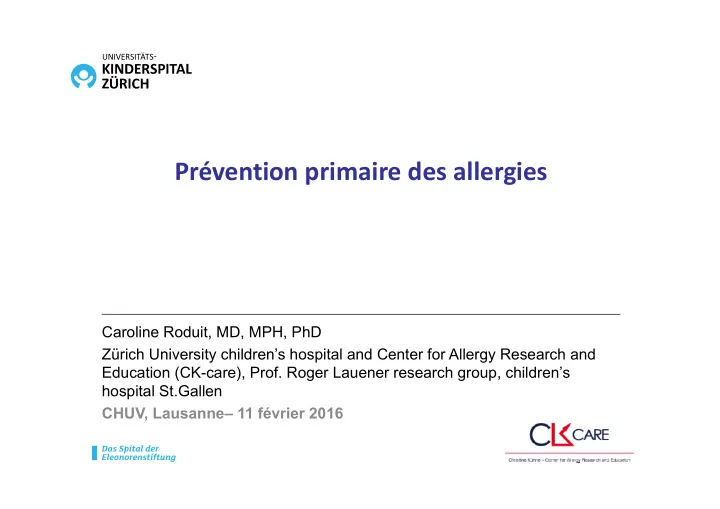

Prévention primaire des allergies Caroline Roduit, MD, MPH, PhD Zürich University children’s hospital and Center for Allergy Research and Education (CK-care), Prof. Roger Lauener research group, children’s hospital St.Gallen CHUV, Lausanne– 11 février 2016
Allergy epidemic The prevalence of asthma in childhood ‐ Asthma is the most common chronic non ‐ communicable diseases, with the earliest onset. ‐ It is expected that more than 50% of all European will be affected in 10 years’ time ‐ > need for effective allergy prevention Eder, Ege, von Mutius, NEJM 2006
Allergy prevention Why there is an increase of allergic diseases? - The hygiene hypothesis - The biodiversity hypothesis - Changes in diet Which factors could prevent the development of allergy? Allergen avoidance strategies have not been successful, as preventive measure.
The hygiene hypothesis ‐ Less hay fever and atopic dermatitis among children with sibilings, large families, having most likely more infections by contact as single children. ‐ Evidences from various studies suggested that “the hygiene hypothesis” plays a large role in the allergy epidemic. Strachan D. Br. Med J. 1989
Farm environment protects against allergies Riedler et al. Lancet 2001
Prenatal exposition to farm protects against allergies: PASTURE study* * P rotection against A llergies St udy in R ural E nvironments Roduit et al. JACI 2011
Prenatal exposure to an increasing number of farm animal species protects against atopic dermatitis Roduit et al. JACI 2011
Exposure to a large diversity of microbes reduces the risk of asthma Ege et al. NEJM 2011
The biodiversity hypothesis Ege et al. NEJM 2011
Infant’s diet and atopic dermatitis *adjusted for farmer, center breastfeeding, parental history of allergies Roduit et al. JACI 2012
Diversity of food introduced in the 1st year of life and atopic dermatitis *Diversity score with major food items: vegetables or fruits, any cereals, meat, bread, cake and yogurt Roduit et al. JACI 2012
Diversity of food introduced in the 1st year of life and asthma *Diversity score with major food items: vegetables or fruits, any cereals, meat, bread, cake and yogurt Roduit et al. JACI 2014
Diversity of food introduced in the 1st year of life and asthma Nwaru et al. JACI 2014
Lifestyle changes in diet in westernised countries: Reduction of consumption of fiber in industrialized countries compared to developing countries: Average consumption of fibers: ‐ In westernised countries: 20 ‐ 25 g per day ‐ In developing countries: 100 g per day
Julia Bollrath and Fiona Powrie, Science 2013
Trompette et al. Nature medicine 2014
Trompette et al. Nature medicine 2014
Human microbiome Cells: - 10% human - 90% microbes -> Microbiota = micro-organism within a given niche Genes: - 1% human - 99% microbes -> Microbiome = all the genetic material of micro-organisms within a given niche - Ley R., et al. Ecological and evolutionary forces shaping microbial diversity in the human intestine. Cell 2006 - Qin J., et al. A human gut microbial gene catalogue established by metagenomic sequencing. Nature 2010
Cesarean section Roduit C. et al. Thorax 2008
Huang L. et al. J Asthma 2015
Dominguez-Bello M. et al. Nature Med. 2016
JACI 2009
Probiotics Cuello-Garcia C. Probiotics for the prevention of allergy. JACI 2015
Probiotics - 29 studies fulfilled a priori specified inclusion criteria for the analyses. - Probiotics reduced the risk of eczema: -> when used by women during the last trimester of pregnancy RR 0.71; 95% CI, 0.60-0.84 -> when used by breast-feeding mothers RR, 0.57; 95% CI, 0.47-0.69 -> or when given to infants RR, 0.80; 95% CI, 0.68-0.94 Conclusion: Probiotics used by pregnant women or breastfeeding mothers and/or given to infants reduced the risk of eczema in infants; however, the certainty in the evidence is low. No effect was observed for the prevention of other allergic conditions. Cuello-Garcia C. Probiotics for the prevention of allergy. JACI 2015
Prebiotics for allergy prevention Cochrane review: „Further research is needed before routine use of prebiotics can be recommended for prevention of allergy in formula fed infants. There is some evidence that a prebiotic supplement added to infant feeds may prevent eczema . It is unclear whether the use of prebiotic should be restricted to infants at high risk of allergy or may have an effect in low risk populations.“ Cochrane Database Syst Rev. 2013 Prebiotics in infants for prevention of allergy. Osborn DA, Sinn JK
Primary prevention of allergic diseases: Nutrition
Maternal diet during pregnancy
Breastfeeding A meta-analysis of 18 prospective studies: - Protective effect on atopic dermatitis of exclusive breastfeeding for 3 months (OR: 0.68; 95% CI: 0.52–0.88), only for infants with a family history of allergy. Gdalevich M, et al. Breastfeeding and the onset of atopic dermatitis in childhood: a systematic review and meta-analysis of of prospective studies. J Am Acad Dermatol. 2001
Breastfeeding Breastfeeding (exclusive at least 3 months): slightly decreased risk of AD (OR 0.89; 95% CI 0.76–1.04) Yang et al. Exclusive breastfeeding and incident of artopic dermatitis in childhood. A systematic review and meta- analysis of prospective cohort studies. British Journal of Dermatology 2009
Hydrolysed formulas for allergy prevention Results: GINI study III - 2000 children, with family history of allergies - 4 blinded formula in first 4 months
Complementary feeding
Complementary feeding
cow milk products was defined as artificial formulas (including hypoallergenic formulas), raw/pasteurized milk, porridge, dairy products, and yogurts
Nwaru, B et al. Timing of infant feeding in relation to childhood asthma and allergic diseases. JACI 2013
Du Toit G. et al. NEJM 2015
Recommandations actuelles: Roethlisberger S. et al. Pediatrica 2016
Recommandations actuelles: Tableau 1 Roethlisberger S. et al. Pediatrica 2016
Roethlisberger S. et al. Pediatrica 2016
Thank you for your attention
Recommend
More recommend